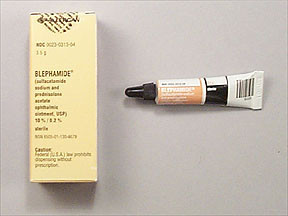SULFACETAMIDE/PREDNISOLONE OINTMENT - OPHTHALMIC
PHONETIC PRONUNCIATION: (SUL-fa-SEET-a-mide/pred-NIS-oh-loan)
COMMON BRAND NAME(S): Blephamide S.O.P.
GENERIC NAME(S): sulfacetamide sodium/prednisolone acetate
Uses
USES: This medication is used to prevent or treat eye infections and to treat swelling in the eye. This product contains an antibiotic (sulfacetamide) that stops the growth of bacteria and a corticosteroid (prednisolone) that reduces inflammation. This medication treats only bacterial eye infections. It will not work for other types of eye infections. Unnecessary use or overuse of any antibiotic can lead to its decreased effectiveness.
How to use SULFACETAMIDE/PREDNISOLONE OINTMENT - OPHTHALMIC
HOW TO USE: Do not wear contact lenses while you are using this medicine. Sterilize contact lenses according to manufacturer's directions and check with your doctor before using them. Apply eye ointment to the affected eye(s) as follows: Wash hands first. To avoid contamination, be careful not to touch the tube tip or let it touch your eye. Tilt your head back, look upward and pull down your lower eyelid to make a pouch. Place a 1/2 inch (1.3 centimeters) strip of ointment into the pouch by squeezing the tube gently. Look downward and gently close your eyes for 1 to 2 minutes. Roll your eyeball in all directions to spread the medication. Try not to blink and do not rub your eye. Repeat these steps for your other eye if so directed. Apply as often as directed by your doctor. Wipe the tip of the ointment tube with a clean tissue to remove excess medication before recapping it. If you are using another kind of eye medication (e.g., drops or ointments), wait at least 10 minutes before applying other medications. Use eye drops before eye ointments to allow the eye drops to enter the eye. Use this medication regularly in order to get the most benefit from it. Continue using it for the full time prescribed even if symptoms disappear after a few days. Stopping the medication too early may allow bacteria to continue to grow, which may result in a relapse of the infection. Do not use this medication for longer than prescribed. If you use it regularly for an extended period of time, do not suddenly stop using it without consulting your doctor. Your dosage may need to be gradually decreased. Inform your doctor if your condition does not improve after 2 days.
Side Effects
Precautions
Interactions
Overdose
Images
Reviews
Disclaimer
IMPORTANT: HOW TO USE THIS INFORMATION: This is a summary and does NOT have all possible information about this product. This information does not assure that this product is safe, effective, or appropriate for you. This information is not individual medical advice and does not substitute for the advice of your health care professional. Always ask your health care professional for complete information about this product and your specific health needs.

No Reviews Yet